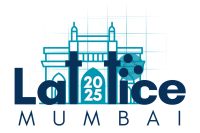Speaker
Description
Scattering processes featuring the strong interactions can be studied using lattice QCD by means of the Lüscher formalism. This approach relies on analyticity and unitarity of the $S$-matrix to relate infinite-volume scattering amplitudes to finite-volume energy levels. However, lattice QCD simulations employing rooted staggered fermions manifest unitarity violation as an $\mathcal{O}(a^2)$ lattice artifact. Moreover, the meson sector of this theory contains multiple pions as a result of taste-splitting effects. These features restrict the applicability of the Lüscher formalism on observables computed using staggered fermions. Backed by calculations in the corresponding effective theory--Staggered Chiral Perturbation Theory--in this work, we discuss possible approaches to deal with the challenges of extracting scattering amplitudes from lattice QCD with staggered quarks. In particular, we focus on the simpler case of pion-pion scattering in the isospin-2 channel, and discuss prospects for other channels.
| Parallel Session (for talks only) | Hadronic and nuclear spectrum and interactions |
|---|

